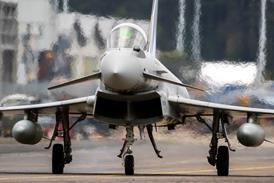Guy Norris/LOS ANGELES
General Electric is studying a long-term strategic engine development plan to create a new family of scaleable powerplants combining the basic architecture of the CFM56 and CF34-10 engines with the very high pressure (HP) ratio of the GE90.
"I'd like to combine these and go to a lower number of stages, and have a pressure ratio in the order of 55 to 60 with a single-stage turbine. This is the vision," says GE advanced engineering general manager, Mike Benzakein. "We believe the technologies necessary to make this happen should be available by 2010, and the resulting products should become available in the following decade," he adds.
The strategy is aimed at lowering the overall cost of ownership, says Benzakein. "We've spent a lot of time over the last two years looking at how to improve reliability and performance, increase simplicity, reduce emissions and lower noise." The answer, he says, is to combine the two-shaft, single-stage HP turbine configuration of the regional and narrow-body engines with the high overall pressure ratio (PR) levels of the GE90. The big engine, developed for the Boeing 777, has an overall PR of almost 43:1 compared to around 28:1 for the smaller engines.
The strategy hinges on two developments already under way: the TECH56 improvement effort for the CFM56 family and other spin-off GE applications, and NASA's Ultra Efficient Engine Technology (UEET) programme. Targets for TECH56, relative to the CFM56-7, include a 4% to 7% fuel burn improvement and 15% to 20% lower maintenance costs, a reduction of nitrous oxide (NOx) emissions to 50% below ICAO levels and a cumulative 20dB noise level margin relative to FAR36 Stage 3. The UEET goals are sized against the GE90 and include a 10% fuel-burn reduction, a 10dB noise reduction and a further 20% cut in NOx as well as a 50% operating cost cut.
Under UEET, which also involves Pratt & Whitney, the PR is being raised from 42 to as much as 60, while compressor exit temperature (T3) will be raised by a relatively modest 38°C (100°F). Turbine inlet temperature will also be raised 93°C to boost performance, while stage count will be reduced from 22 to 15 to lower maintenance cost. "We intend to redefine the state of the art," says Benzakein.
Discrete enabling technologies being explored include high-swept fan blades with suction side-bleed, which increase PR but still maintain adequate stall margin, case treatments by the compressor to improve stall margin, a 20:1 PR six-stage compressor and a new low emission combustor with a ceramic matrix composite liner.
The UEET programme is also targeting a single-stage 5.5 PR HP turbine versus the 4.5 PR unit being developed for TECH56. It will also include a counter-rotating, low-pressure turbine similar to military designs like the YF120. "It should give us a 1% improvement in overall turbine efficiency," says Benzakein.
GE also plans to introduce new technology features developed through these initiatives into current or near-term development engines, should the market warrant it. Chevron nozzles, for example, have been tested on TECH56 as a noise reduction feature, and will be baseline on the CF34-8C5 engine for the Bombardier CRJ900.
Source: Flight International























